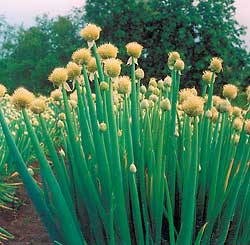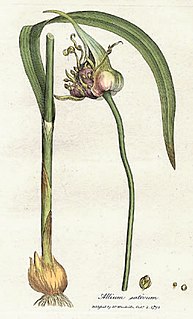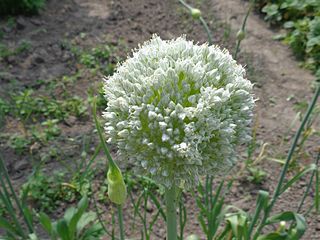
The shallot is a plant related to onion, and is typically a botanical variety or cultivar group of the species Allium cepa. This was formerly classified as a separate species, A. ascalonicum, a name now considered a synonym of the currently accepted name.

Scallions are vegetables derived from various species in the genus Allium. Scallions have a milder taste than most onions. Their close relatives include garlic, shallot, leek, chive, and Chinese onions.

Allium tuberosum is a species of plant native to the Chinese province of Shanxi, and cultivated and naturalized elsewhere in Asia and around the world.

Allium fistulosum, the Welsh onion, also commonly called bunching onion, long green onion, Japanese bunching onion, and spring onion, is a species of perennial plant, often considered to be a kind of scallion.

William Thomas Stearn was a British botanist. Born in Cambridge in 1911, he was largely self-educated, and developed an early interest in books and natural history. His initial work experience was at a Cambridge bookshop, but he also had a position as an assistant in the university botany department. At the age of 29 he married Eldwyth Ruth Alford, who later became his collaborator. He died in London in 2001.

Allium moly, also known as yellow garlic, golden garlic and lily leek, Is a species of flowering plant in the genus Allium, which also includes the flowering and culinary onions and garlic. A bulbous herbaceous perennial from the Mediterranean, it is edible and also used as a medicinal and ornamental plant.
Jimbu is an herb belonging to the onion family, used extensively in some regions of Nepal and in some central Himalayan states of India, like Uttarakhand, where it is called Jamboo / Faran. It is composed of two species of Allium, A. hypsistum and A. przewalskianum. The herb, which has a taste in between onion and chives, is most commonly used dried. In the Mustang district of Nepal, it is used to flavor vegetables, pickles, and meat. In the rest of Nepal it is most commonly used to flavor urad dal or lentils. The dried leaves are fried in ghee to develop their flavor. After harvest, people store Jimbu dried for later use since it is a seasonal herb.

Allium stipitatum, Persian shallot, is an Asian species of onion native to central and southwestern Asia.
Allium przewalskianum is an Asian species of wild onion in the Amaryllis family.

Allium siculum, known as honey garlic, Sicilian honey lily, Sicilian honey garlic, or Mediterranean bells, is a European and Turkish species of plants genus Allium. It is native to the regions around the Mediterranean and Black Seas, and grown in other regions as an ornamental and as a culinary herb.
The following outline is provided as an overview of and topical guide to herbs and spices:

Van herbed cheese is a type of cheese made out of sheep's or cow's milk. Ripened cheese varieties containing herbs are traditional in Turkey and have been manufactured for more than 200 years in the east and southeast of the country. They are manufactured from raw milk, semi-hard in texture and salty in taste and have the aroma of garlic or thyme due to added herbs. Twenty-five types of herb, including Allium, Thymus, Silene and Ferula species which are most popular, are used individually or as appropriate mixtures. The most popular of these cheeses is Otlu which is produced mainly in the Van Province of Turkey in small dairies and villages, but now is produced in other cities of the eastern region of Turkey and its popularity increases continuously throughout Turkey.

Allium cyathophorum is a Chinese species of the genus Allium (onions) in the amaryllis family, Amaryllidaceae. It grows at elevations from 2700 metres up to 4600 metres.

Allium fasciculatum is a species of onions known from the Himalayas of Bhutan, Sikkim, Nepal, and the Chinese provinces of Qinghai, Sichuan and Tibet. It grows at elevations of 2200–5400 m.
Allium humile is an Asian species of wild onion found at high elevations in India, Nepal, northern Pakistan, Tibet, and Yunnan.

Allium is a genus of monocotyledonous flowering plants that includes hundreds of species, including the cultivated onion, garlic, scallion, shallot, leek, and chives. The generic name Allium is the Latin word for garlic, and the type species for the genus is Allium sativum which means "cultivated garlic".

The precise taxonomy of the genus Allium is still poorly understood with incorrect descriptions being widespread. With over 850 species distributed over the Northern hemisphere Allium is the sole genus in the Allieae, one of four tribes of subfamily Allioideae (Amaryllidaceae). New species continue to be described and Allium is both highly variable and one of the largest monocotyledonous genera, but the precise taxonomy of Allium is poorly understood, with incorrect descriptions being widespread. The difficulties arise from the fact that the genus displays considerable polymorphism and has adapted to a wide variety of habitats. Furthermore, traditional classications had been based on homoplasious characteristics. However, the genus has been shown to be monophyletic, containing three major clades, although some proposed subgenera are not. Some progress is being made using molecular phylogenetic methods, and the internal transcribed spacer (ITS) region, including the 5.8S rDNA and the two spacers ITS1 and ITS2, is one of the more commonly used markers in the study of the differentiation of the Allium species.

Allium guttatum, spotted garlic, is a species of wild garlic native to Morocco, Algeria, Tunisia, Libya, Portugal, Spain, France, Italy, Sardinia, Sicily, the Balkan Peninsula, the Aegean Islands, Turkey, Cyprus, Romania, and Ukraine. Described in 1809, by 1819 it was being cultivated in British gardens as an ornamental.













